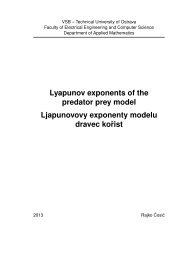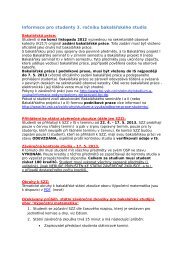The Boundary Element Method for the Helmholtz Equation ... - FEI VÅ B
The Boundary Element Method for the Helmholtz Equation ... - FEI VÅ B
The Boundary Element Method for the Helmholtz Equation ... - FEI VÅ B
Create successful ePaper yourself
Turn your PDF publications into a flip-book with our unique Google optimized e-Paper software.
58 4 Discretization and Numerical RealizationΓ DE D (Dirichlet elements)E N (Neumann elements)Γ NN D (Dirichlet nodes)N N (Neumann nodes)Figure 4.4: Triangulation of ∂Ω <strong>for</strong> <strong>the</strong> mixed boundary value problem.with matrices M h and K κ,h defined by (4.8) and (4.9), respectively. <strong>The</strong> Galerkin equations(4.13) can now be represented as 1D κ,h g D =2 MT h − KT κ,h g N .Note that in <strong>the</strong> system of linear equations above <strong>the</strong> transpositions are not conjugatetranspositions and only involve reordering of <strong>the</strong> original matrices.4.3.3 Interior Mixed <strong>Boundary</strong> Value ProblemFor <strong>the</strong> solution to <strong>the</strong> interior mixed boundary value problem (3.37) we consider <strong>the</strong>symmetric approach given by <strong>the</strong> variational <strong>for</strong>mulationa(s, t, q, r) = F (q, r) <strong>for</strong> all q ∈ H −1/2 (Γ D ), r ∈ H 1/2 (Γ N ) (4.15)with unknown functions s ∈ H −1/2 (Γ D ), t ∈ H 1/2 (Γ N ), <strong>the</strong> bilinear <strong>for</strong>m<strong>the</strong> right-hand sideF (q, r) := 12 I + K κa(s, t, q, r) := ⟨V κ s, q⟩ ΓD − ⟨K κ t, q⟩ ΓD + ⟨K ∗ κs, r⟩ ΓN + ⟨D κ t, r⟩ ΓN , 1˜g D , q − ⟨V κ˜g N , q⟩ ΓD +Γ D2κI − K∗ ˜g N , r − ⟨D κ˜g D , r⟩ ΓNΓ Nand some fixed prolongations of <strong>the</strong> Cauchy data ˜g D , ˜g N .Be<strong>for</strong>e we proceed, we divide <strong>the</strong> boundary elements into two groups, E D denoting<strong>the</strong> set of all elements with <strong>the</strong> Dirichlet boundary condition and E N denoting <strong>the</strong> set ofNeumann elements. Similarly, we divide <strong>the</strong> set of boundary nodes into sets N D and N N(see Figure 4.4). Note that in <strong>the</strong> following text we also use <strong>the</strong> symbols E D , E N , N D andN N to denote <strong>the</strong> cardinality of <strong>the</strong> corresponding sets.Note that <strong>for</strong> smooth enough functions t, s we have t| ΓD = 0 and s| ΓN = 0. Thus, weseek <strong>the</strong> unknown functions in <strong>the</strong> approximate <strong>for</strong>mst ≈ t h := t i ϕ i ∈ T ϕ (Γ N ), s ≈ s h := s j ψ j ∈ T ψ (Γ D ) (4.16)i∈N N j∈E D









